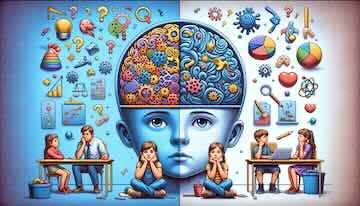
- Detalles
La urticaria, comúnmente conocida como ronchas, es una reacción de la piel que puede ser desencadenada por varios factores, incluido el estrés. Este artículo explora cómo el estrés puede provocar o exacerbar la urticaria, ofreciendo una perspectiva sobre las interacciones entre la piel y las emociones, así como consejos para el manejo y tratamiento.
Leer más: Urticaria por Estrés: Conexión entre la Piel y las Emociones

- Detalles
El miedo o la ansiedad ante los análisis de sangre es una preocupación común para muchas personas. Conocida a veces como tripanofobia (miedo a las agujas), esta ansiedad puede variar desde un leve nerviosismo hasta un temor intenso. Entender y abordar esta ansiedad es crucial para asegurar que las personas reciban los cuidados de salud necesarios sin estrés excesivo.
Leer más: Entendiendo y Abordando la Ansiedad Ante los Análisis de Sangre

- Detalles
Life satisfaction is a key indicator of emotional well-being. This test will help you reflect on your current level of satisfaction across various areas of your life.

- Detalles
La distimia y la depresión mayor son dos trastornos del estado de ánimo que, aunque comparten ciertas similitudes, tienen características distintivas importantes. Este artículo busca aclarar las diferencias entre ambos, proporcionando información valiosa para una mejor comprensión y manejo de estos trastornos.

- Detalles
La decisión de tener hijos es uno de los pasos más significativos en la vida de una pareja. Sin embargo, el proceso de concebir puede convertirse en una fuente de estrés considerable, especialmente cuando no se logra con facilidad. Este artículo explora cómo el estrés asociado con intentar concebir puede afectar las relaciones de pareja y ofrece consejos para manejar estas dificultades.
Leer más: El Estrés de la Búsqueda de la Paternidad: Impacto en las Relaciones de Pareja

- Detalles
El Trastorno por Déficit de Atención e Hiperactividad (TDAH) es una de las condiciones neuropsiquiátricas más comunes en niños y adolescentes. Se caracteriza por síntomas de inatención, hiperactividad y impulsividad. Sin embargo, en los últimos años, ha surgido un intenso debate sobre si el TDAH está siendo sobrediagnosticado.
Leer más: ¿Está Sobre Diagnosticado el TDAH? Una Mirada Crítica

- Detalles
La psicología, como campo de la salud mental, está en constante evolución, con la emergencia de nuevas terapias y enfoques de tratamiento. Estas innovaciones están diseñadas para abordar una gama de trastornos y problemas psicológicos, ofreciendo opciones más efectivas y personalizadas para los pacientes.

- Detalles
El desmayo, médicamente conocido como síncope, es una pérdida breve y repentina de la conciencia, generalmente causada por una disminución del flujo sanguíneo al cerebro. Aunque comúnmente asociado con factores físicos, existe una creciente curiosidad sobre si la ansiedad puede provocar desmayos. Este artículo explora la relación entre la ansiedad y los desmayos, basándose en evidencia científica y opiniones médicas.

- Detalles
Misanthrope Personality Test
This test explores traits commonly associated with misanthropy, such as distrust, social isolation, and a critical outlook on society. Answer each question honestly to determine your personality type.
Each trait evaluated in this test represents aspects of misanthropy, such as the need for solitude or feelings of superiority. By identifying these traits, the test aims to provide insights into your personality.
The results categorize you into one of three levels: low, moderate, or high misanthropy. It is important to interpret these results with self-awareness.
Remember, no test can fully define your personality, but it can help you reflect on your preferences and tendencies.
Let's begin the test!

- Detalles
El dolor de espalda es una de las quejas más comunes en la población adulta, impactando significativamente la calidad de vida. A menudo tratado con medicamentos, terapia física o cirugía, existe un creciente interés en enfoques alternativos como el mindfulness. Este artículo explora cómo la práctica del mindfulness puede ser una herramienta eficaz para el manejo del dolor de espalda.
Leer más: Mindfulness para el Manejo del Dolor de Espalda: Una Aproximación Integral

- Detalles
La salud mental es un aspecto crucial de nuestro bienestar general, pero a menudo es mal entendida y rodeada de estigma. Comprender los trastornos psicológicos más comunes es un paso fundamental para fomentar una mayor concienciación y empatía hacia quienes los padecen. Este artículo busca ofrecer una visión clara y comprensiva de los ocho trastornos psicológicos más comunes, abordando sus síntomas, causas y tratamientos disponibles. Al aumentar nuestro conocimiento sobre estos trastornos, podemos contribuir a desmitificarlos y apoyar mejor a aquellos que luchan contra ellos.

- Detalles
Sociotropy Personality Test
Sociotropy is a personality trait characterized by a need for approval, acceptance, and concern for others' opinions.
This test is designed to help you understand your level of sociotropy.

- Detalles
We, psychologists, often feel fascinated by one of the most profound and universal aspects of the human experience: our attitudes. From the seemingly mundane—like a preference for coffee over tea—to the deeply impactful, such as political beliefs or social biases, our attitudes are powerful. They shape how we see the world, influence our decisions, and, often, they define our interactions with others. But what are attitudes, exactly? And perhaps more intriguingly, why do they change? How attitudes can change?
What Are Attitudes?
At their core, attitudes are defined as a settled way of thinking or feeling about something. They aren’t fleeting thoughts or random opinions; rather, they are well-organized and consistent predispositions. These predispositions influence how we react to people, ideas, objects, and events. Attitudes are generally categorized as positive, negative, or neutral. They are complex and can be directed toward a broad range of targets—from individual people to larger abstract concepts, like justice or freedom.
"An attitude is essentially a lens through which we view the world. It’s like a pair of glasses we wear every day, often without even realizing it."Attitudes can be so ingrained that they feel like second nature, and yet, they are malleable under certain conditions. This brings us to a deeper question: how do psychologists, with their tools and theories, understand and define attitudes?
How Psychologists Define Attitudes
Psychologists define attitudes as evaluative statements that involve emotional, behavioral, and cognitive components. Let’s unpack these three components, often referred to as the ABC model of attitudes:
1. Affective Component
This is the emotional reaction we have toward a subject. It encompasses the feelings or emotions associated with the attitude object. For instance, if you feel warm and happy at the thought of spending time with your family, that positive emotion forms part of your attitude toward family.
2. Behavioral Component
This component reflects the way an attitude influences how we behave or act. For example, if you have a positive attitude toward environmental conservation, you might choose to recycle regularly, purchase eco-friendly products, or engage in advocacy.
3. Cognitive Component
The cognitive component refers to the beliefs or thoughts we have about an object. If you believe that exercising is essential for health, this belief forms part of your attitude toward physical fitness. The cognitive component often involves reasoning and knowledge that supports the affective and behavioral aspects.
These three components create a comprehensive view of attitudes as both inner feelings and beliefs and outward expressions in behavior. Now, let’s delve into how these attitudes form in the first place.
How Do Attitudes Form?
Understanding attitude formation is essential because it sheds light on why we think and feel the way we do—and why our attitudes might change over time. There are several key factors that influence the formation of attitudes:
1. Socialization
Much of our attitude formation happens through socialization. From a young age, we are surrounded by family, peers, and cultural norms that shape our perspectives. Parents, for example, often impart attitudes toward religion, education, or societal roles. As we grow, these attitudes may either be reinforced or challenged by new social interactions.
2. Personal Experience
Direct experiences can also form attitudes. For instance, if someone has a positive experience with a particular product or brand, they may develop a favorable attitude toward it. Similarly, negative experiences can create aversions or dislikes. Personal experiences are particularly impactful in shaping strong, long-lasting attitudes because they are grounded in firsthand knowledge and emotions.
3. Media and Influence
We live in a world where media plays a pervasive role. Advertisements, movies, social media, and news all communicate messages that can influence our attitudes. Media doesn’t just provide information; it often evokes emotions and can subtly shift our views, sometimes without us even realizing it.
4. Cognitive Consistency
Humans naturally seek cognitive consistency, meaning we prefer our beliefs, emotions, and actions to align. When faced with information that conflicts with an existing attitude, we often experience discomfort, or cognitive dissonance, which can lead us to change our attitude to reduce this discomfort.
All these factors work together to form our attitudes in ways that are sometimes predictable, sometimes surprising. But just as attitudes can form, they can also change. Let’s explore why that happens.
Why Do Attitudes Change?
How attitudes can change? Attitudes are not fixed; they are dynamic and can shift over time. Changes in attitudes may happen gradually or as a result of specific events. Psychological theories offer valuable insights into why and how these changes occur.
1. Cognitive Dissonance Theory
One of the foundational theories in psychology is cognitive dissonance theory, developed by psychologist Leon Festinger in the 1950s. According to this theory, when there is an inconsistency between our beliefs and actions, we experience psychological discomfort or dissonance. This discomfort often motivates us to change either our behavior or beliefs to restore balance.
For example, a person who values health but smokes may experience dissonance due to the conflict between their belief and behavior. To reduce this discomfort, they might quit smoking or convince themselves that smoking “isn’t that harmful.” Dissonance, thus, is a powerful force that can drive attitude change.
2. Social Influence and Persuasion
Attitudes are also susceptible to social influence. Studies in social psychology, such as those by Solomon Asch and Stanley Milgram, demonstrate that people often conform to the opinions or behaviors of others. Persuasive communication, whether from friends, authority figures, or even advertisements, can shift attitudes. A highly credible source, a strong argument, and the right emotional appeal are all components that make persuasive messages more effective.
3. Elaboration Likelihood Model (ELM)
The Elaboration Likelihood Model (ELM), proposed by Richard Petty and John Cacioppo, suggests that there are two main routes to attitude change: the central route and the peripheral route. The central route involves thoughtful consideration of the arguments presented and leads to enduring attitude change. The peripheral route relies on superficial cues, such as the attractiveness of the speaker, and often leads to more temporary shifts.
For instance, a public service announcement that provides in-depth statistics and logical reasoning about the benefits of vaccination targets the central route. Conversely, a commercial that uses an attractive celebrity to endorse a product is tapping into the peripheral route.
4. Self-Perception Theory
Another intriguing perspective comes from self-perception theory, proposed by psychologist Daryl Bem. This theory suggests that individuals often infer their own attitudes by observing their behaviors, especially when they lack strong pre-existing beliefs. For example, if someone finds themselves volunteering frequently, they may conclude, “I must enjoy helping others.” This shift in self-perception can lead to genuine attitude change.
5. Exposure and Familiarity
The mere exposure effect is a phenomenon where repeated exposure to a stimulus increases our preference for it. This explains why people often develop positive attitudes toward things they encounter regularly, whether it’s a familiar brand or a popular song. Familiarity breeds comfort, and comfort can subtly shift attitudes from neutral or even negative to positive.
The Human Side of Attitude Change
At its heart, the psychology of attitude change is a reminder of our human complexity. Attitudes reflect our experiences, values, and identities, and changes in them are not simply logical; they are deeply emotional and often social. People’s attitudes can shift as they encounter life’s changes—moving to a new city, going through personal challenges, or forming new relationships. These shifts are part of the journey of growth and adaptation, unique to each person.
Understanding how and why attitudes change not only enriches our understanding of ourselves but also fosters empathy. When we recognize that attitudes are fluid and shaped by a variety of experiences, we can approach others with a more open mind, knowing that their beliefs and behaviors are part of a much larger personal narrative.
Embracing Change and Growth
Ultimately, the ability of attitudes to change is what makes personal growth possible. Without the flexibility to adapt our views, we would remain trapped in outdated perceptions, unable to grow or connect with others who think differently. Attitude change allows us to evolve, to learn from our experiences, and to become more aligned with our values over time.
For therapists, educators, leaders, and everyday individuals, understanding how attitudes form and transform is crucial for fostering positive interactions, encouraging growth, and guiding constructive change. When we encourage open-mindedness, facilitate respectful dialogue, and nurture environments where people feel safe to re-evaluate their beliefs, we are creating space for meaningful and healthy attitude shifts.
It´s a powerful experience to see firsthand how transformative attitude change can be, not just for individuals, but for families, communities, and even larger societies. The power to reflect, reconsider, and ultimately reshape our attitudes gives us the potential to become our best selves. As we continue to learn more about the psychology of attitudes, we open up new possibilities for understanding ourselves and each other, moving toward a future where our attitudes not only reflect who we are but also who we are becoming.
Final Thoughts
Attitudes are complex, multifaceted, and deeply personal, yet they are also open to influence and change. They are an ever-evolving aspect of the human psyche, shaped by our interactions, experiences, and the broader social world we live in. Through insights from psychology, we gain a roadmap for understanding why we feel, believe, and act the way we do, and how we can guide these attitudes toward greater empathy, openness, and understanding.
So, the next time you find yourself holding onto a belief, pause and ask yourself, “Is this serving me? Could there be a new way to see this?” Because in the end, the capacity to change our attitudes is one of the most powerful tools we have for growth, connection, and self-discovery.
Leer más: How Attitudes Can Change: A Psychological Exploration

- Detalles
Attachment Style Test
Attachment styles are behavioral patterns that reflect how we relate to others and develop based on our early experiences.

- Detalles
La depresión es un trastorno del estado de ánimo que afecta a millones de personas en todo el mundo. Sus síntomas incluyen tristeza persistente, falta de interés en actividades previamente disfrutadas y una disminución significativa en la función diaria. Una de las intervenciones terapéuticas eficaces para el tratamiento de la depresión es la Activación Conductual (AC). Este artículo proporciona una visión general de las técnicas de AC y cómo pueden ayudar a las personas con depresión.
Leer más: Técnicas de Activación Conductual para la Depresión: Una Guía de Intervención

- Detalles
En la vida cotidiana, los términos “sentimientos” y “emociones” a menudo se usan indistintamente. Sin embargo, en el ámbito de la psicología, estos conceptos tienen diferencias significativas que son importantes de entender. Este artículo busca explorar estas diferencias para proporcionar una comprensión más clara de nuestras experiencias internas.
Leer más: Sentimientos y Emociones: Entendiendo las Diferencias

- Detalles
La anorexia nerviosa es un trastorno alimentario grave caracterizado por la restricción extrema de la ingesta de alimentos y un miedo intenso a ganar peso. Este trastorno, que afecta tanto a hombres como a mujeres, tiene profundas implicaciones físicas y psicológicas. Uno de los aspectos críticos en el tratamiento de la anorexia es fomentar la aceptación corporal, un proceso complejo pero fundamental para la recuperación.
Leer más: La aceptación corporal en el tratamiento de la anorexia

- Detalles
La represión, uno de los mecanismos de defensa más conocidos y debatidos en el campo de la psicología, fue introducida por Sigmund Freud en el marco de la teoría psicoanalítica. Este mecanismo actúa a nivel inconsciente y sirve como un medio para que la mente evite la ansiedad o el malestar psíquico al bloquear ciertos pensamientos, deseos o recuerdos, particularmente aquellos que son dolorosos o inaceptables para el yo consciente.

- Detalles
The Big Five theory is a widely recognized model in the field of personality psychology. This model suggests that there are five main dimensions that describe individual differences in behavior and attitudes.

- Detalles
Las emociones positivas son aquellos estados afectivos que nos provocan sensaciones de placer, satisfacción, alegría o bienestar. A diferencia de las emociones negativas, que nos preparan para la acción ante situaciones de amenaza o peligro, las emociones positivas amplían nuestra atención y fomentan la creatividad y la exploración.
Leer más: Explorando los Tipos, Impactos y Fomento de las Emociones Positivas

